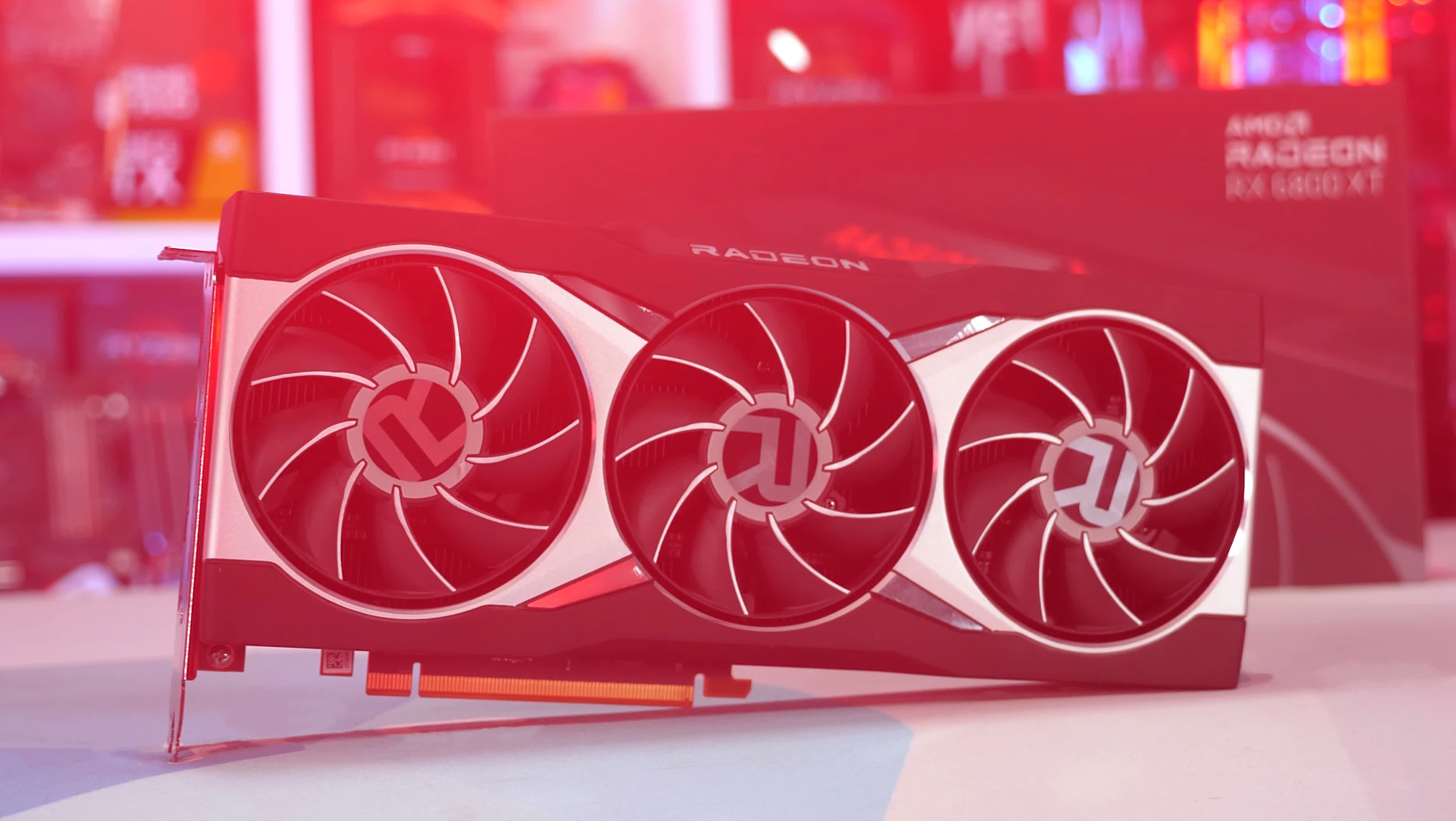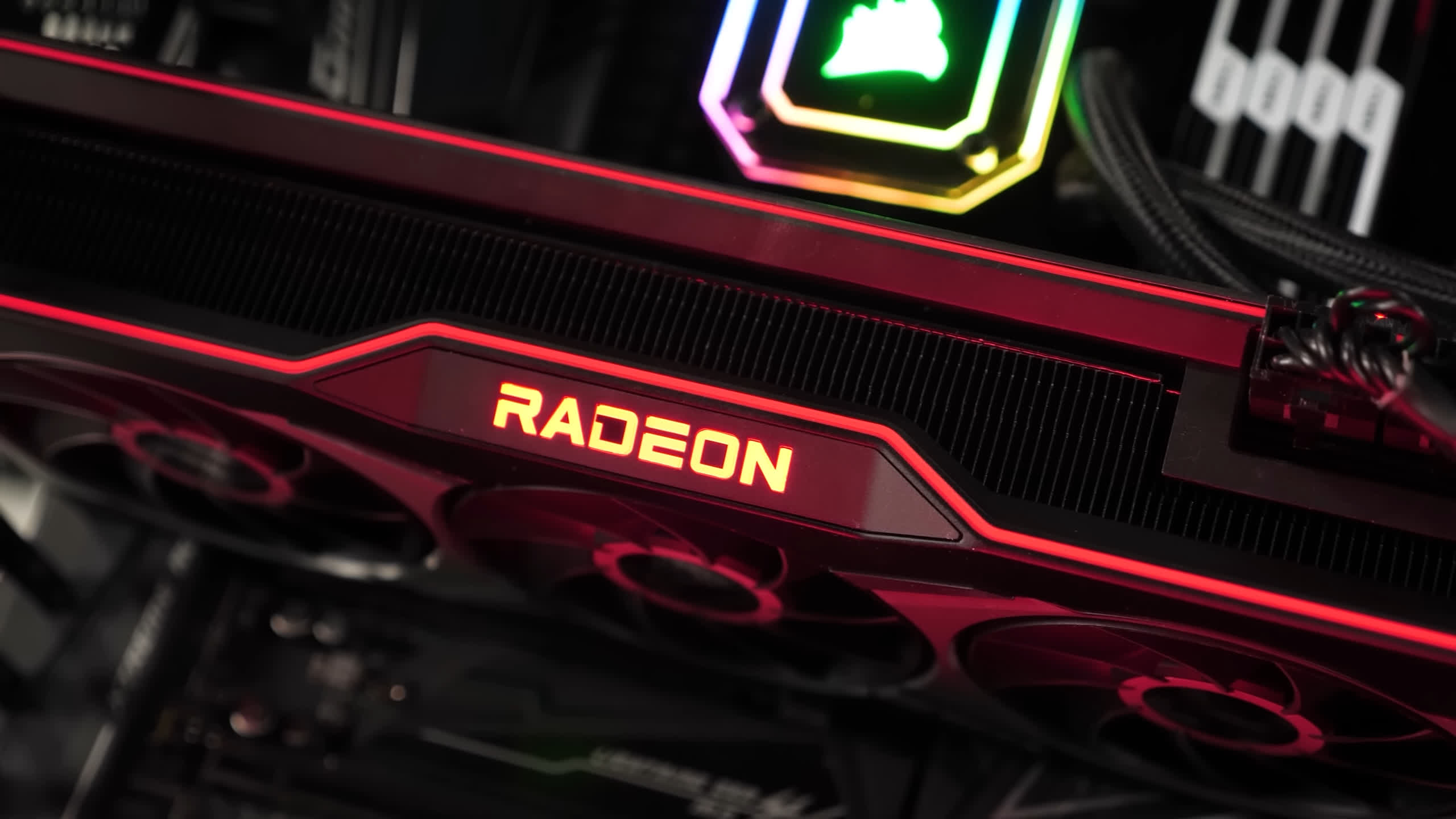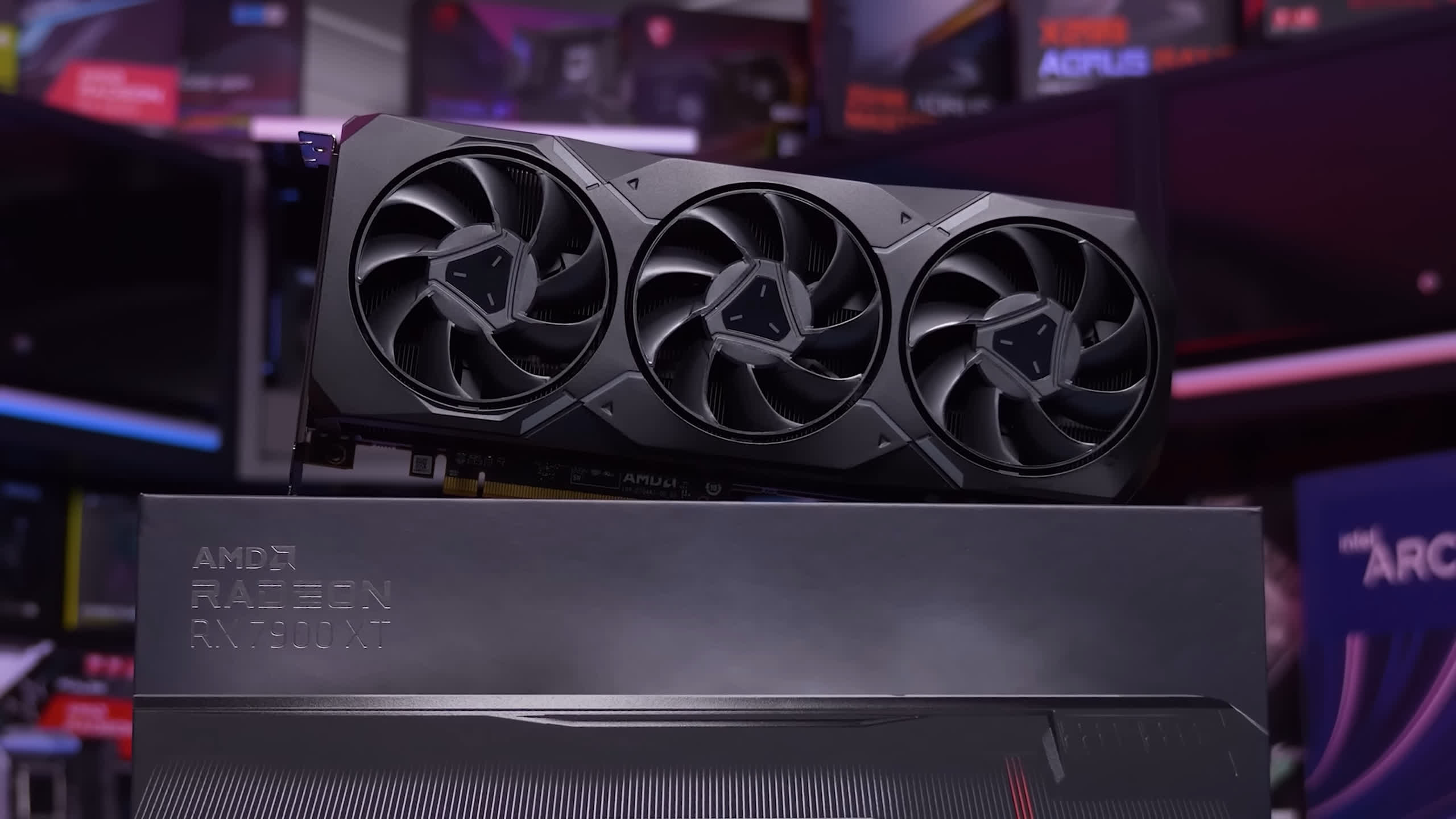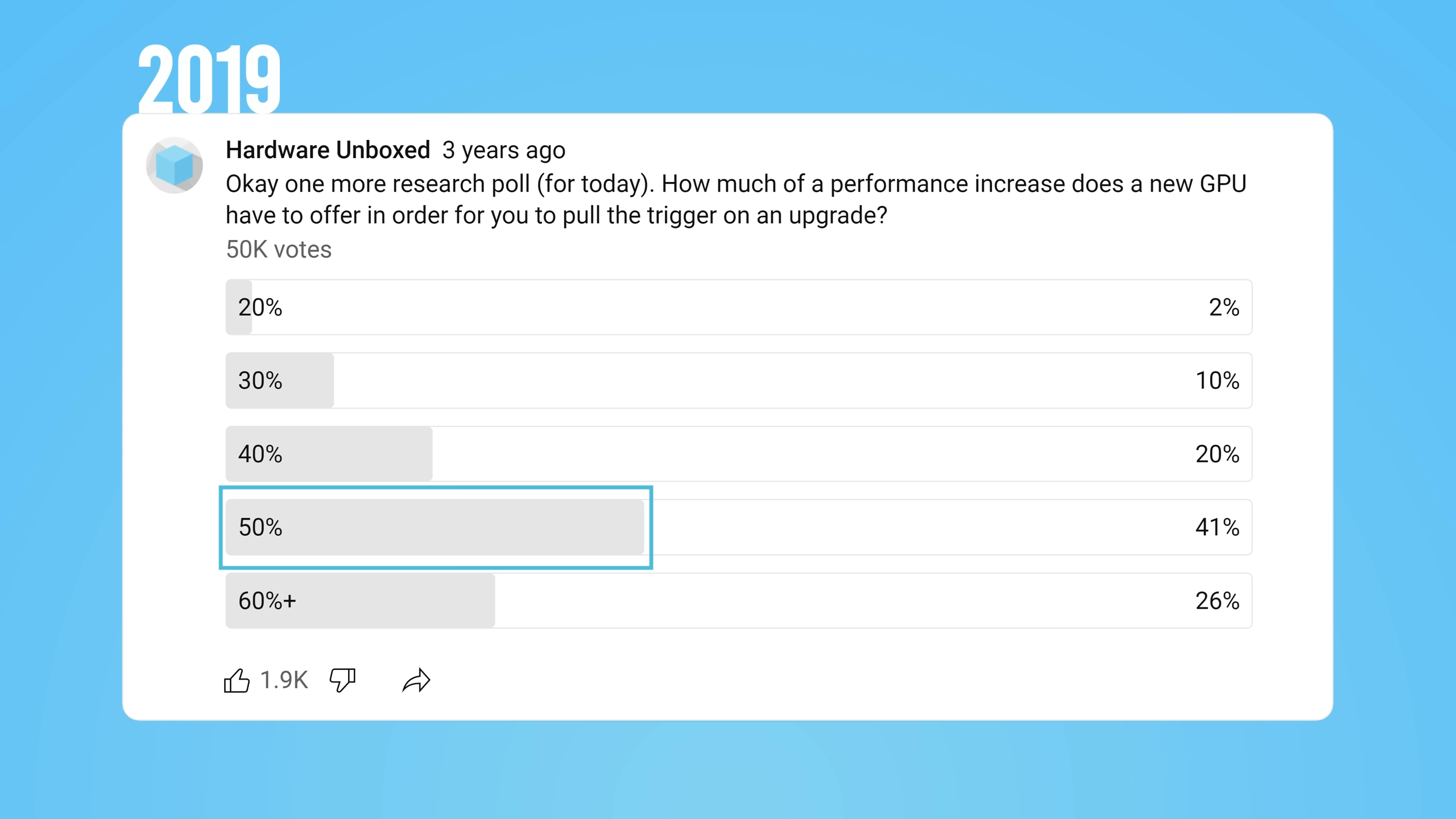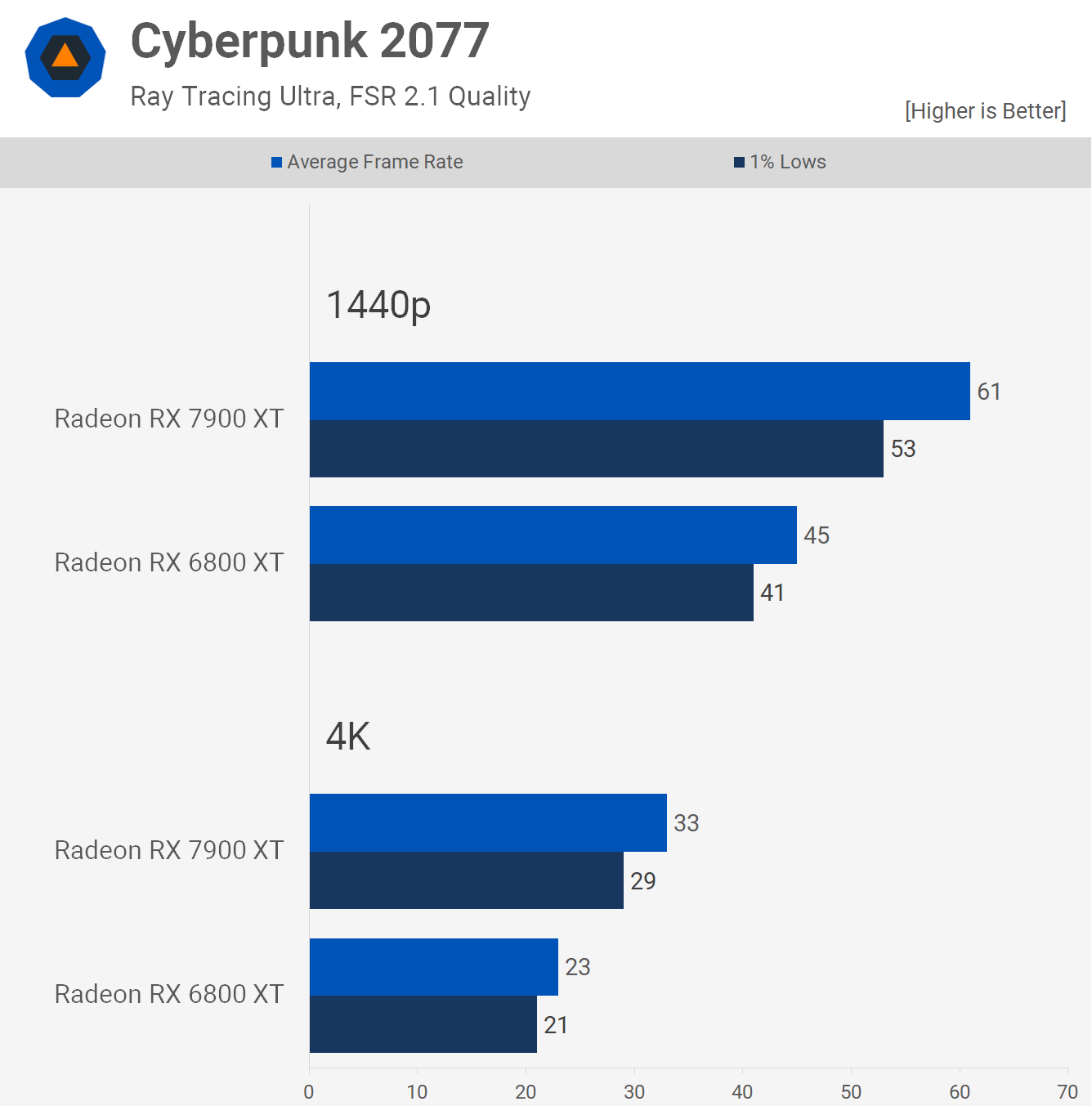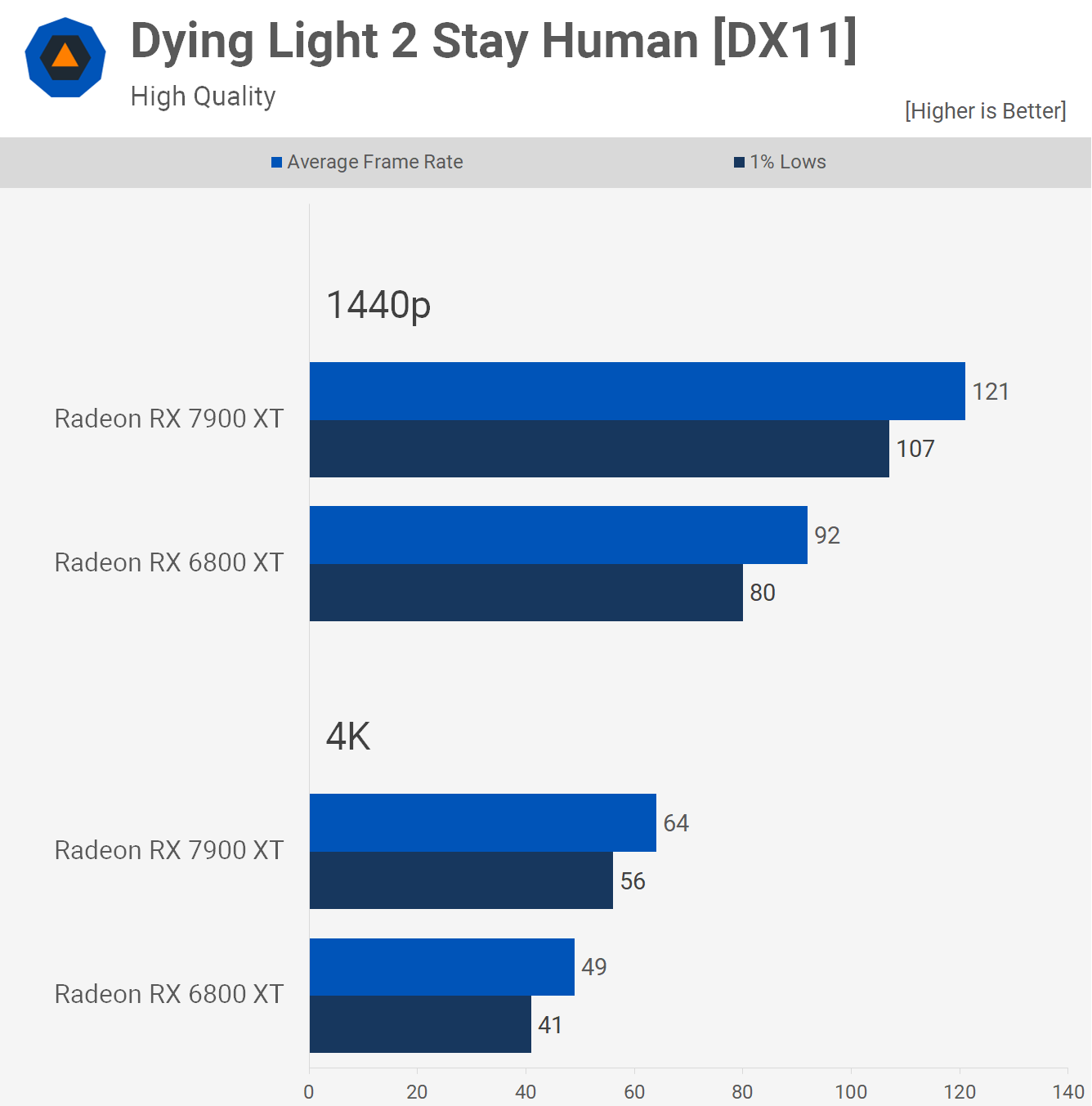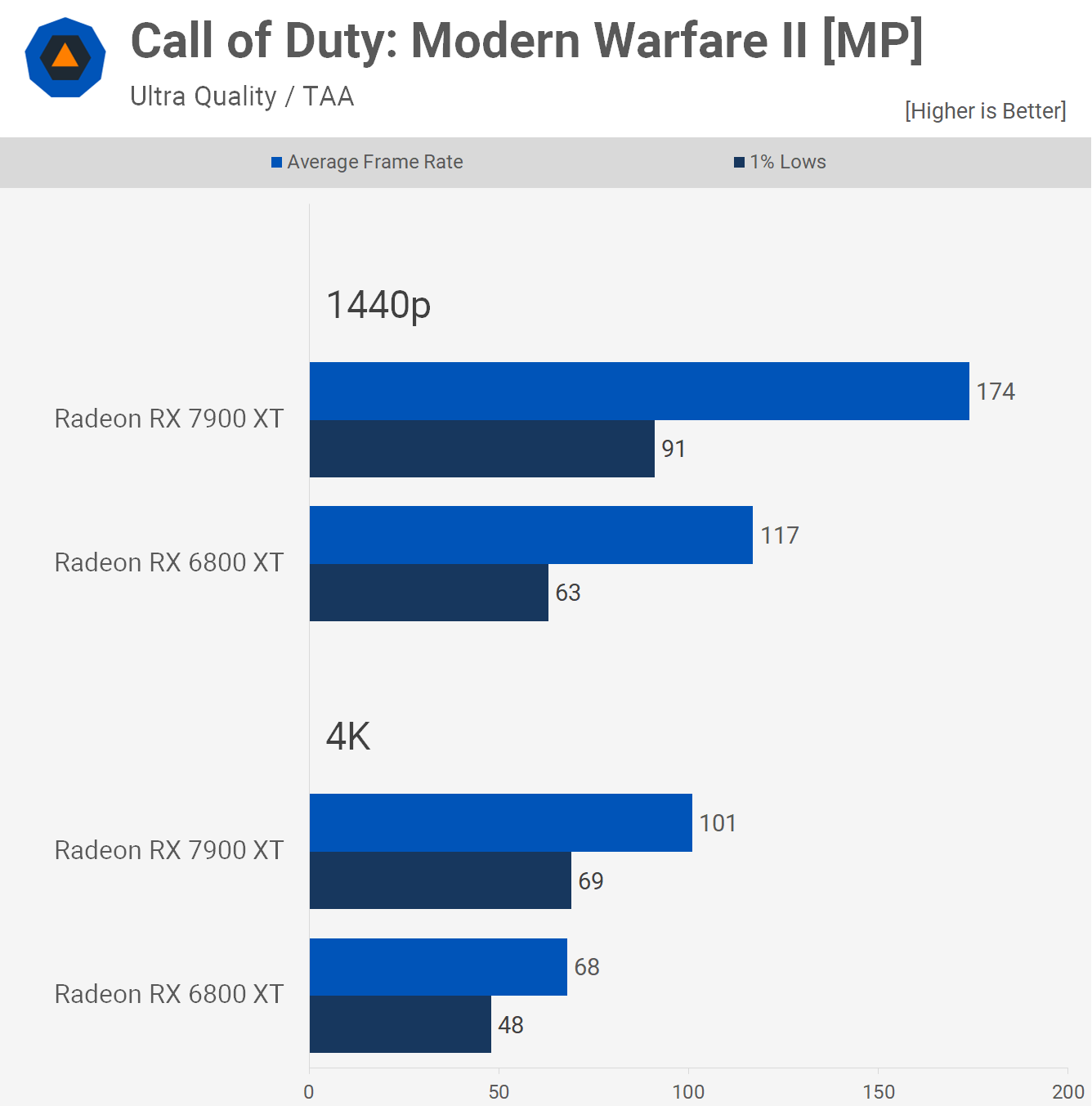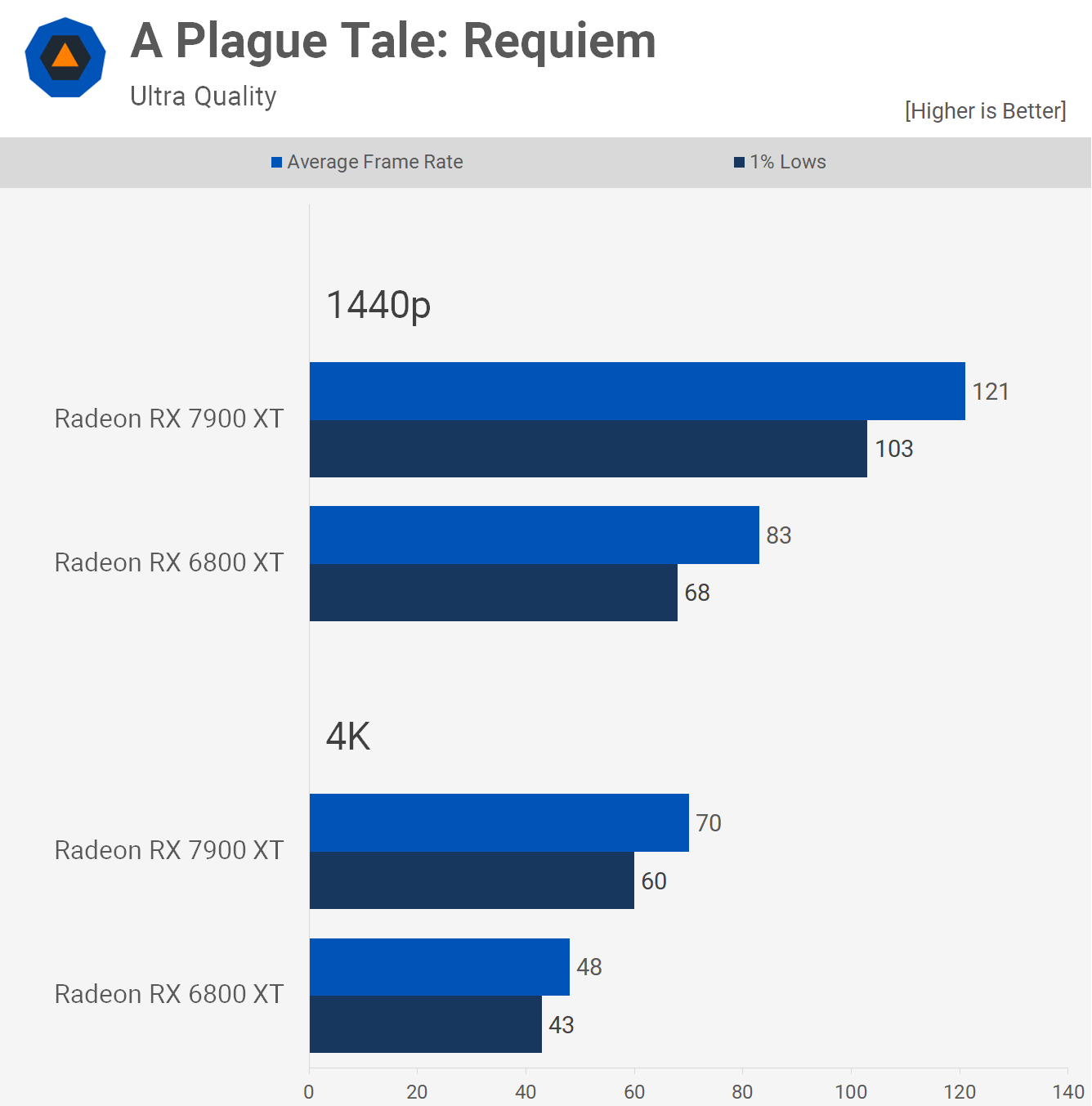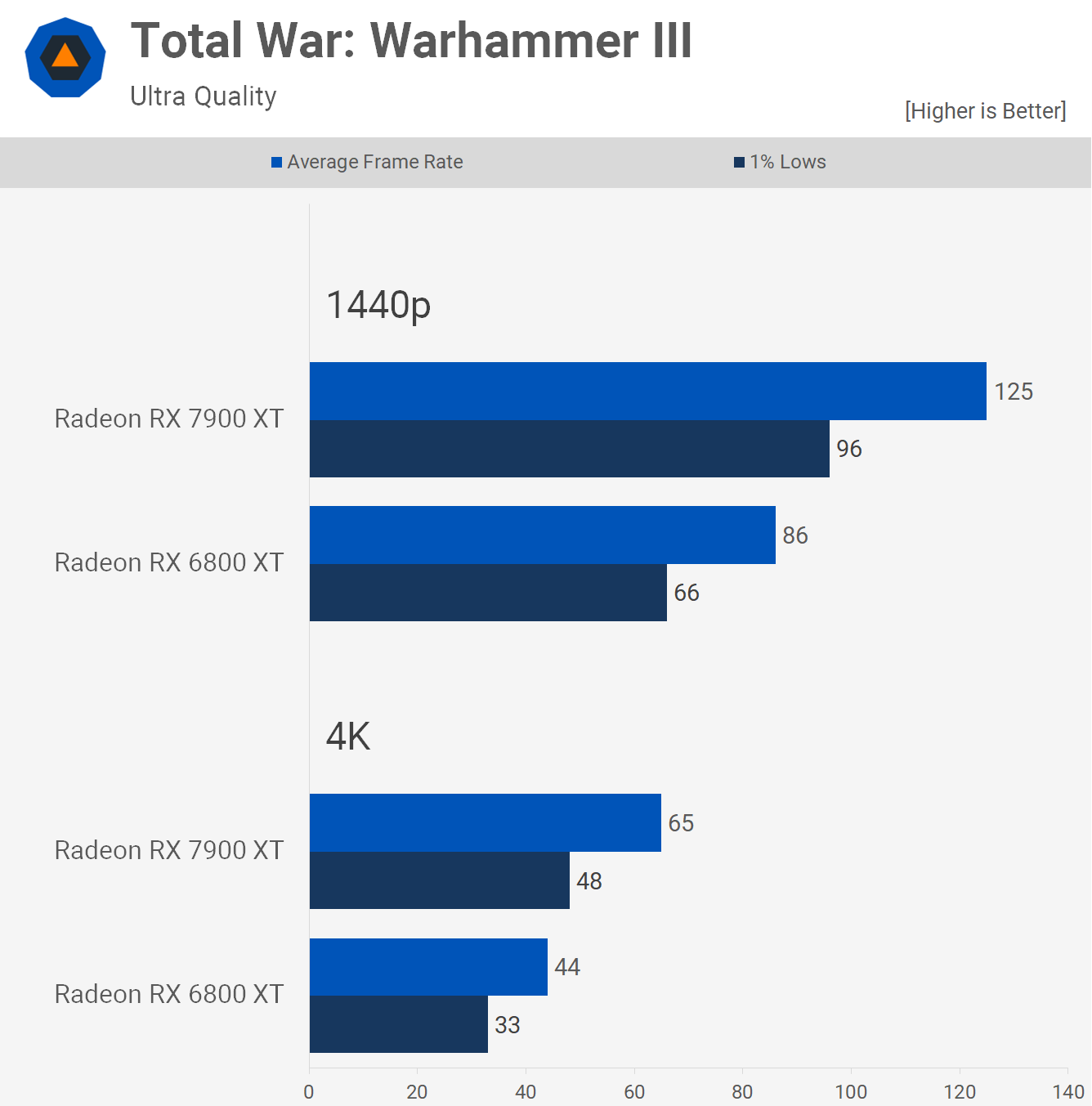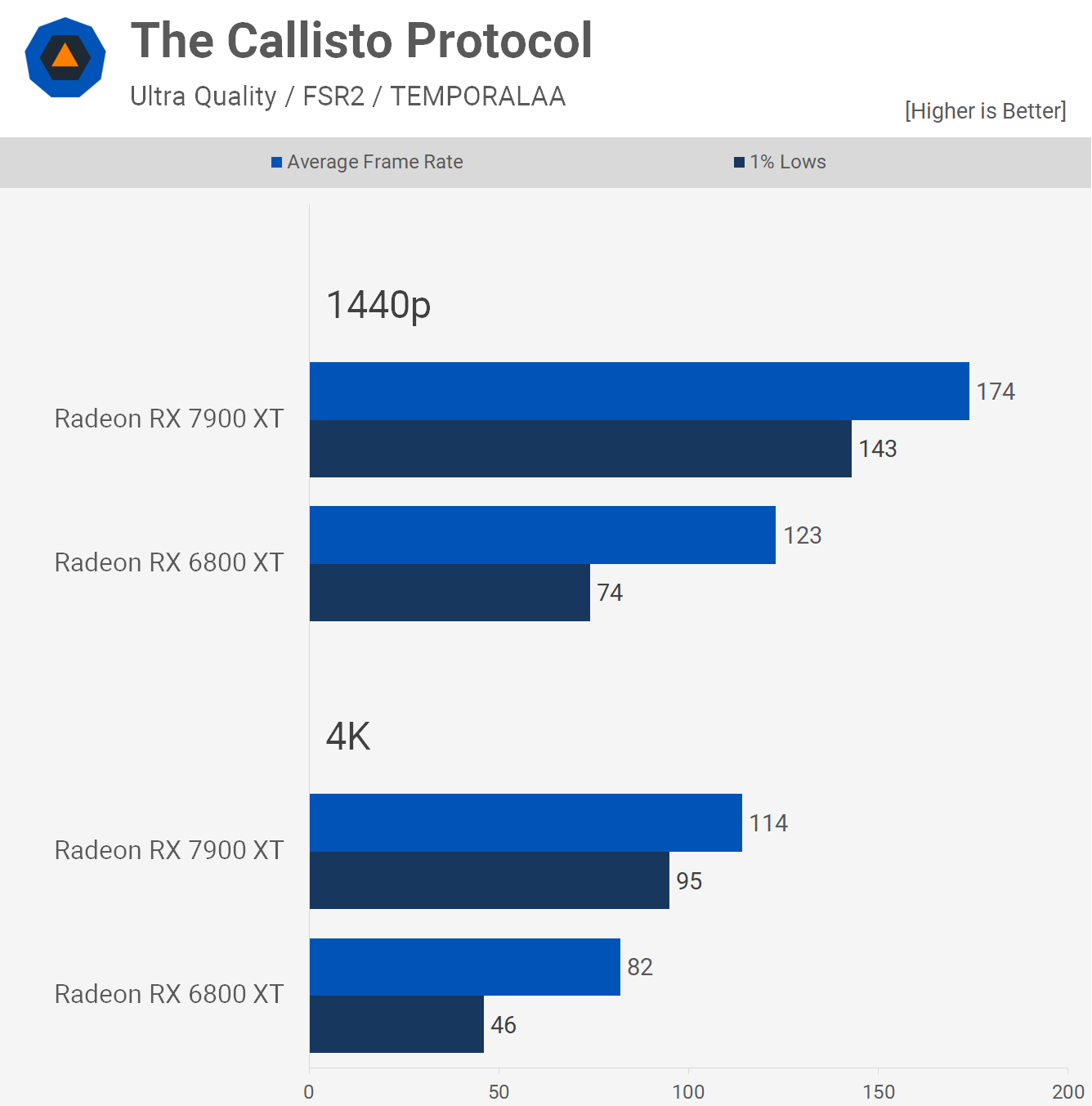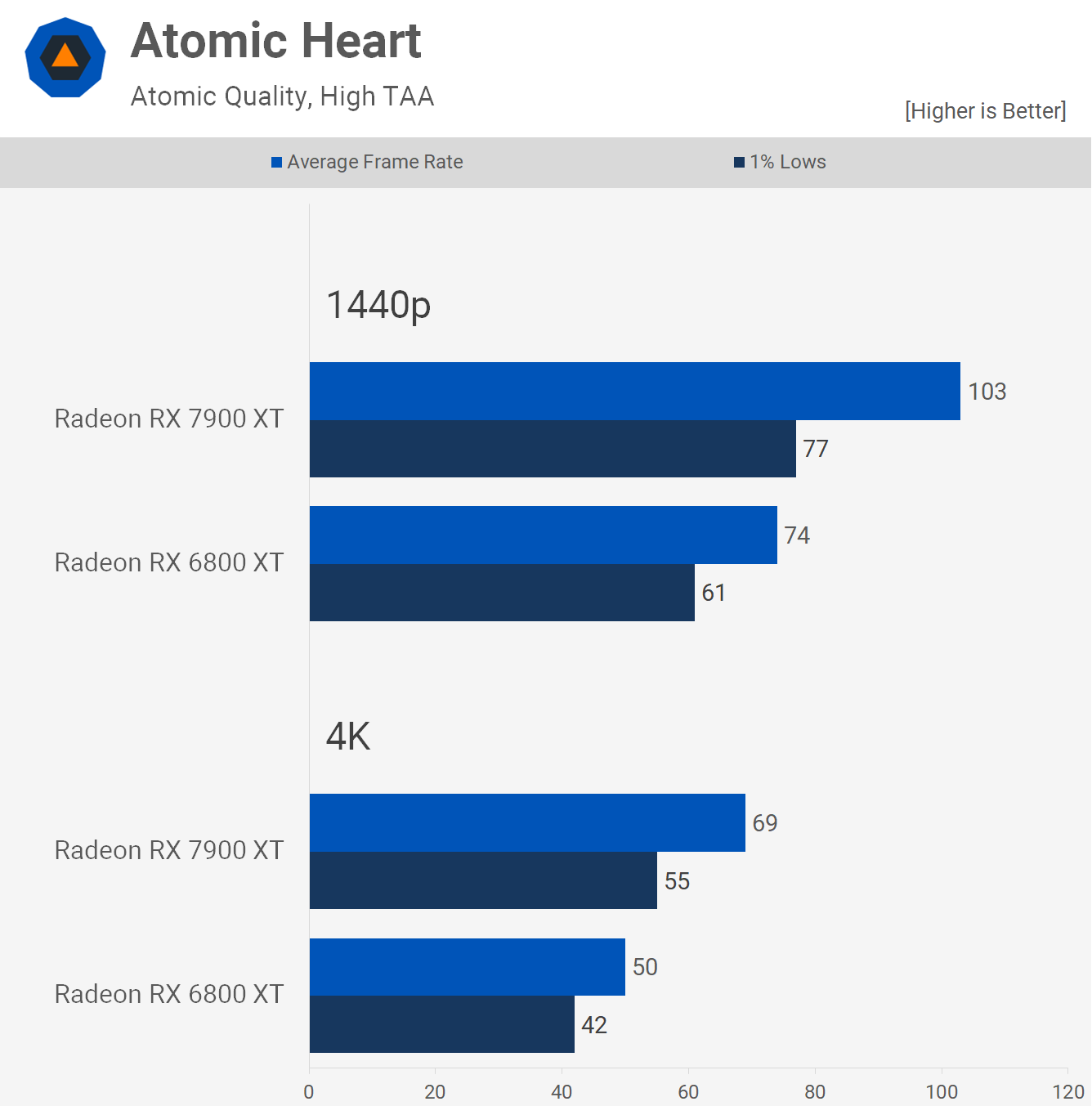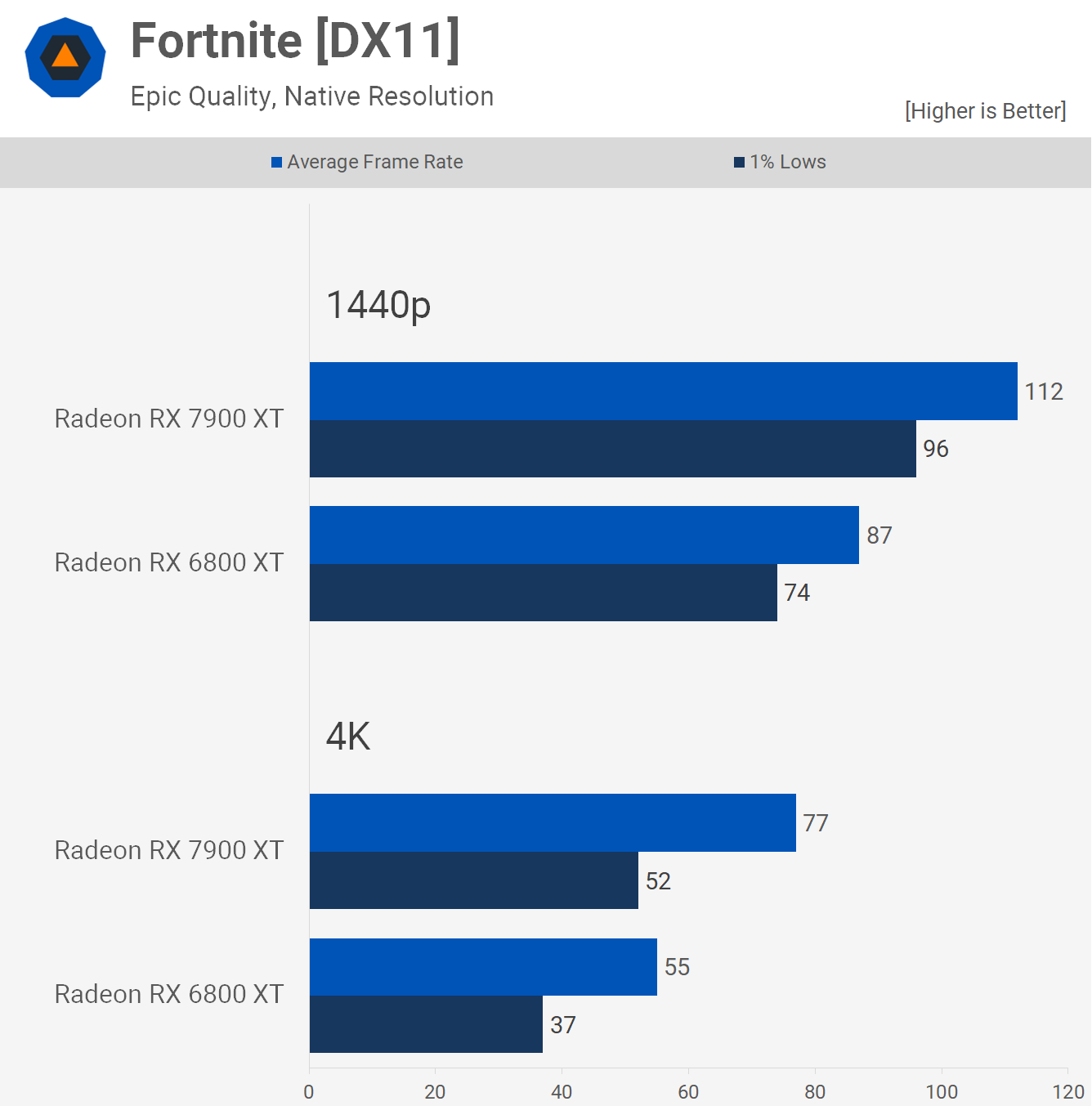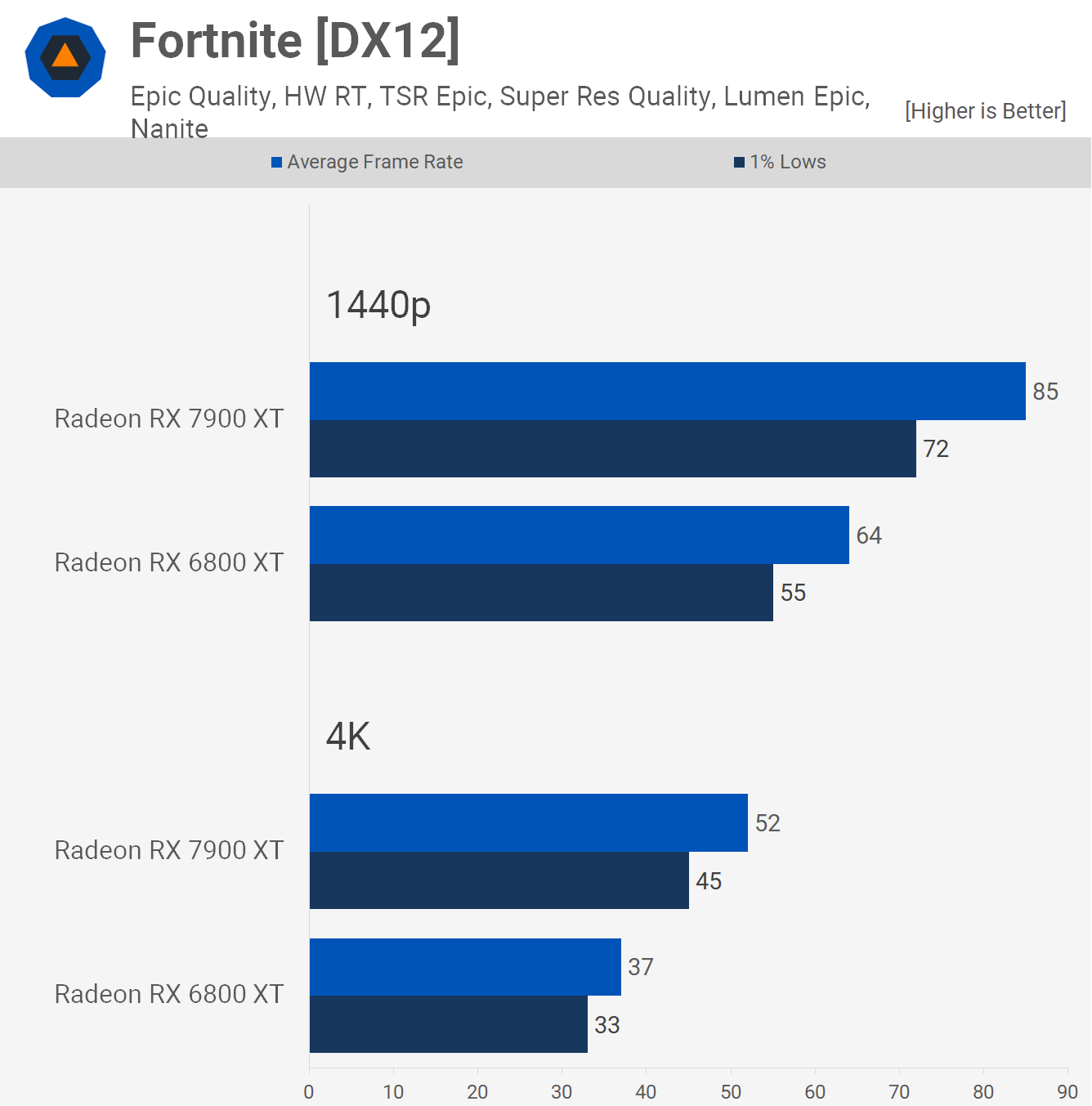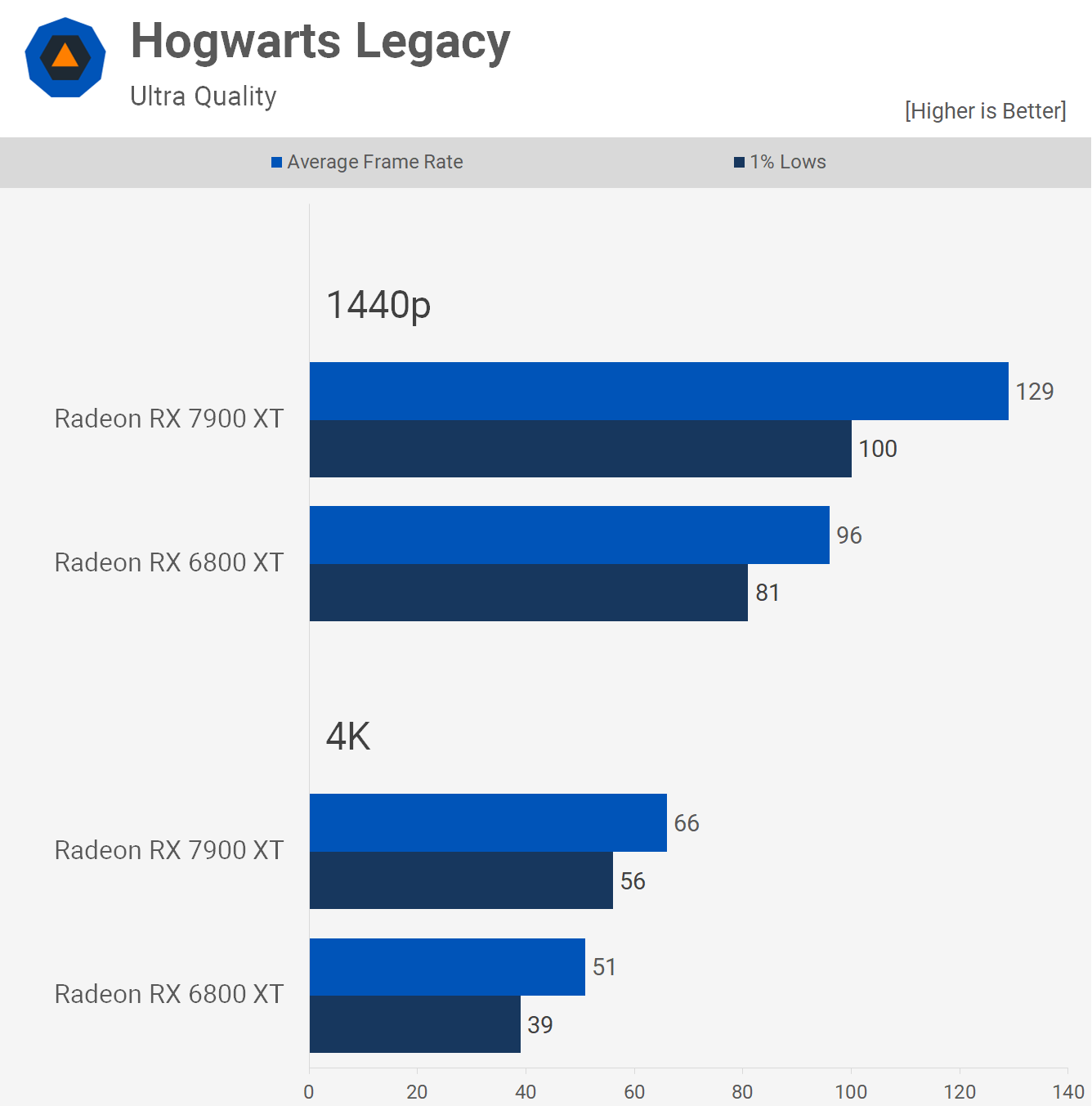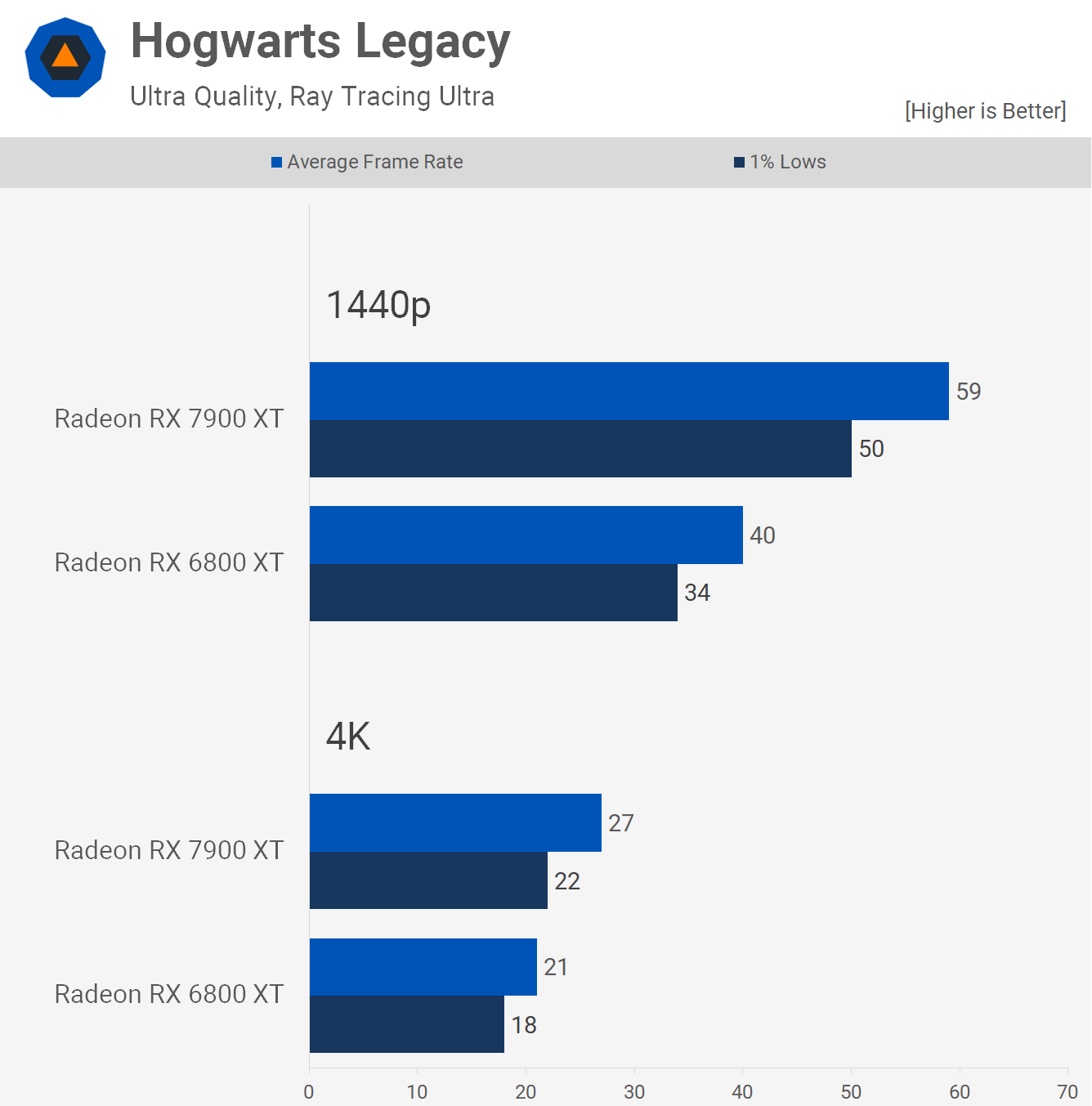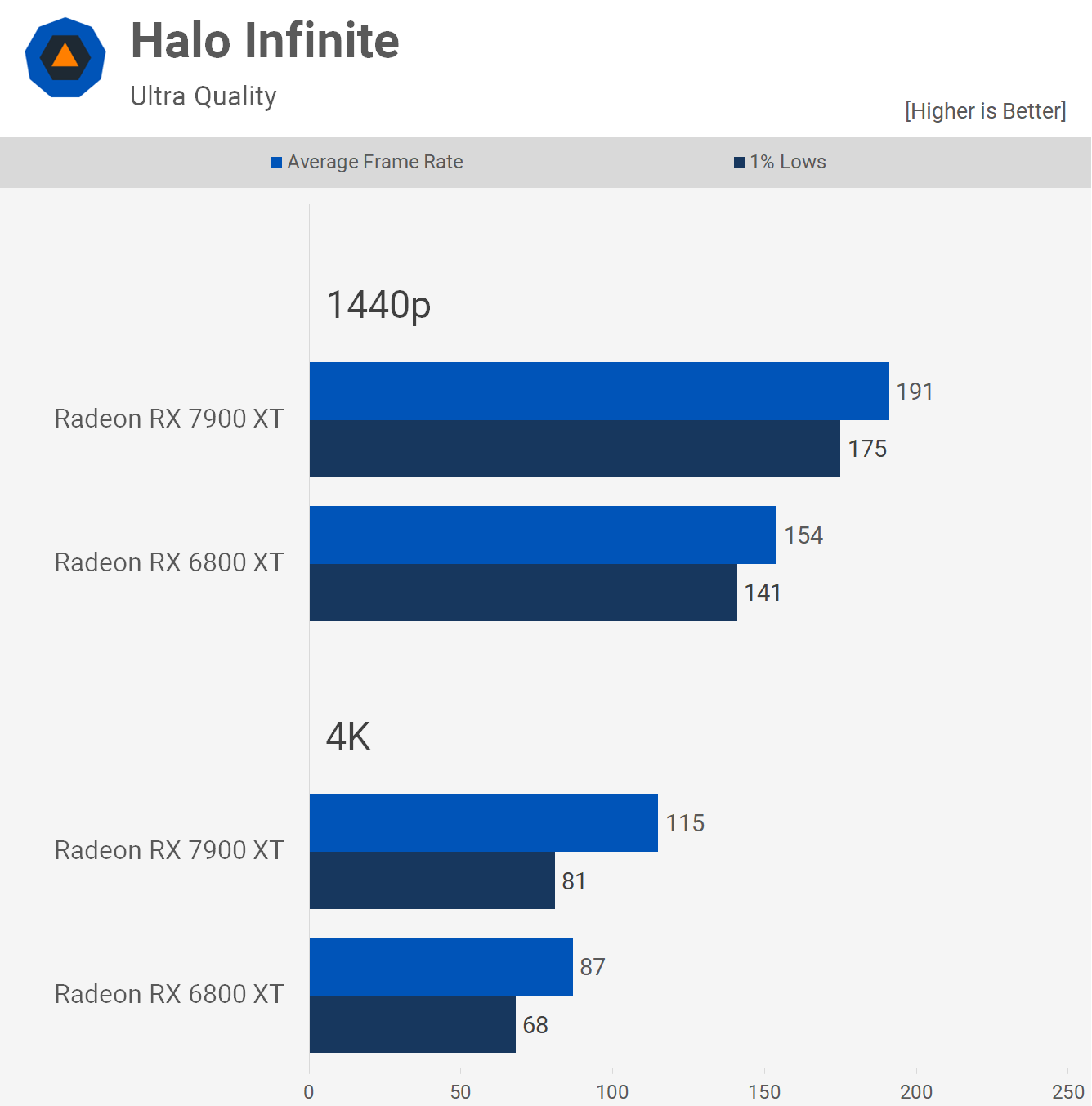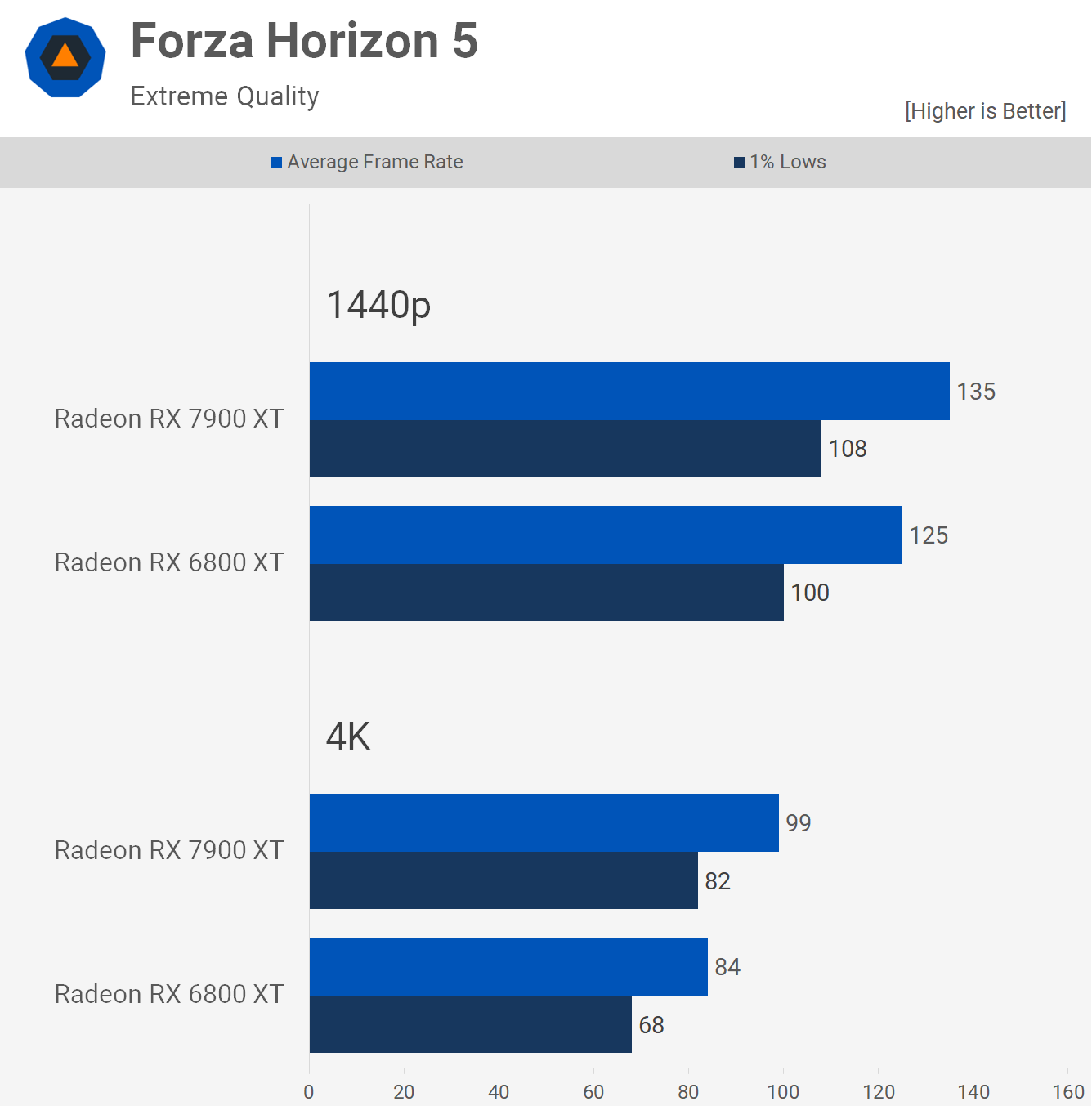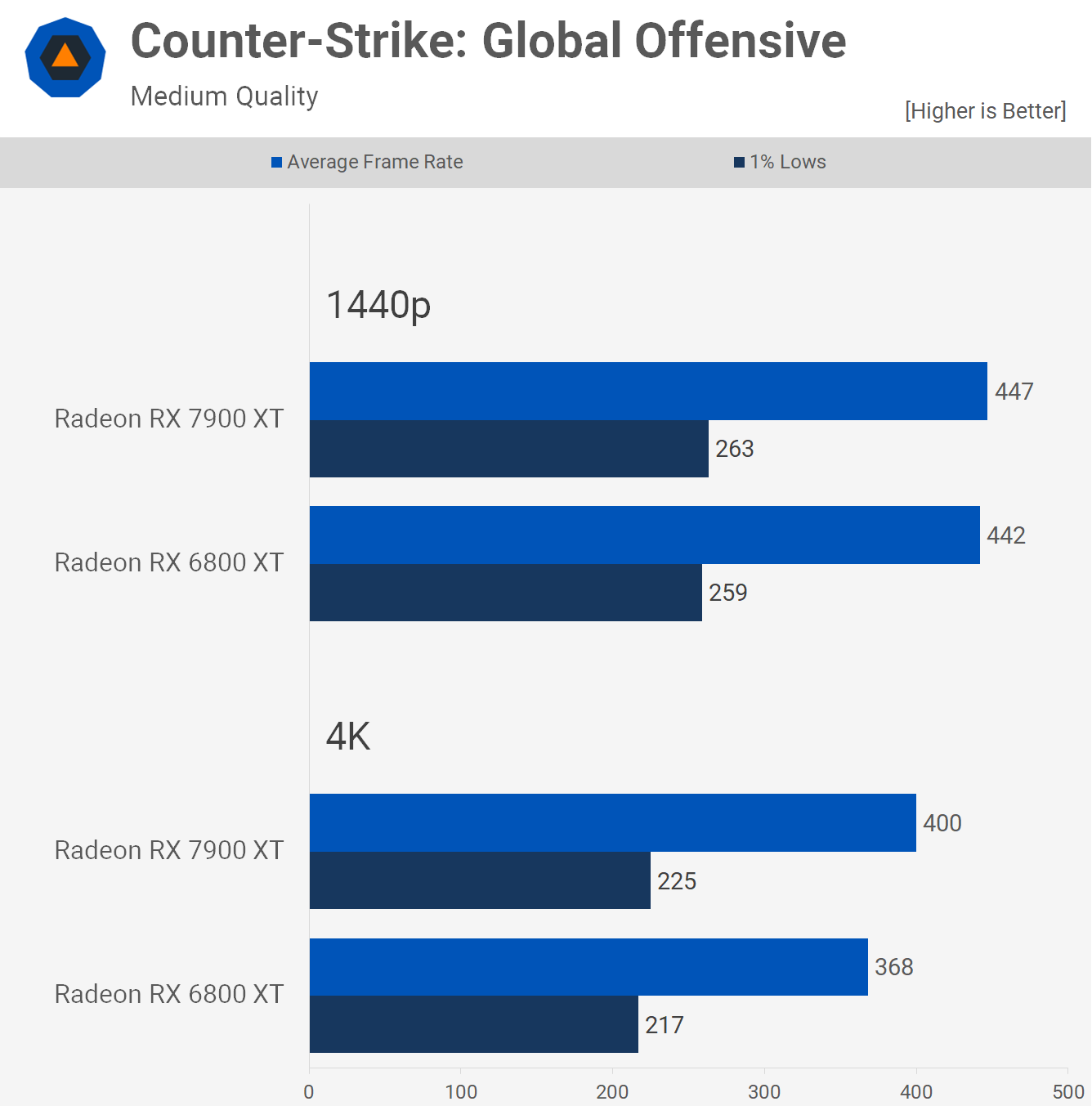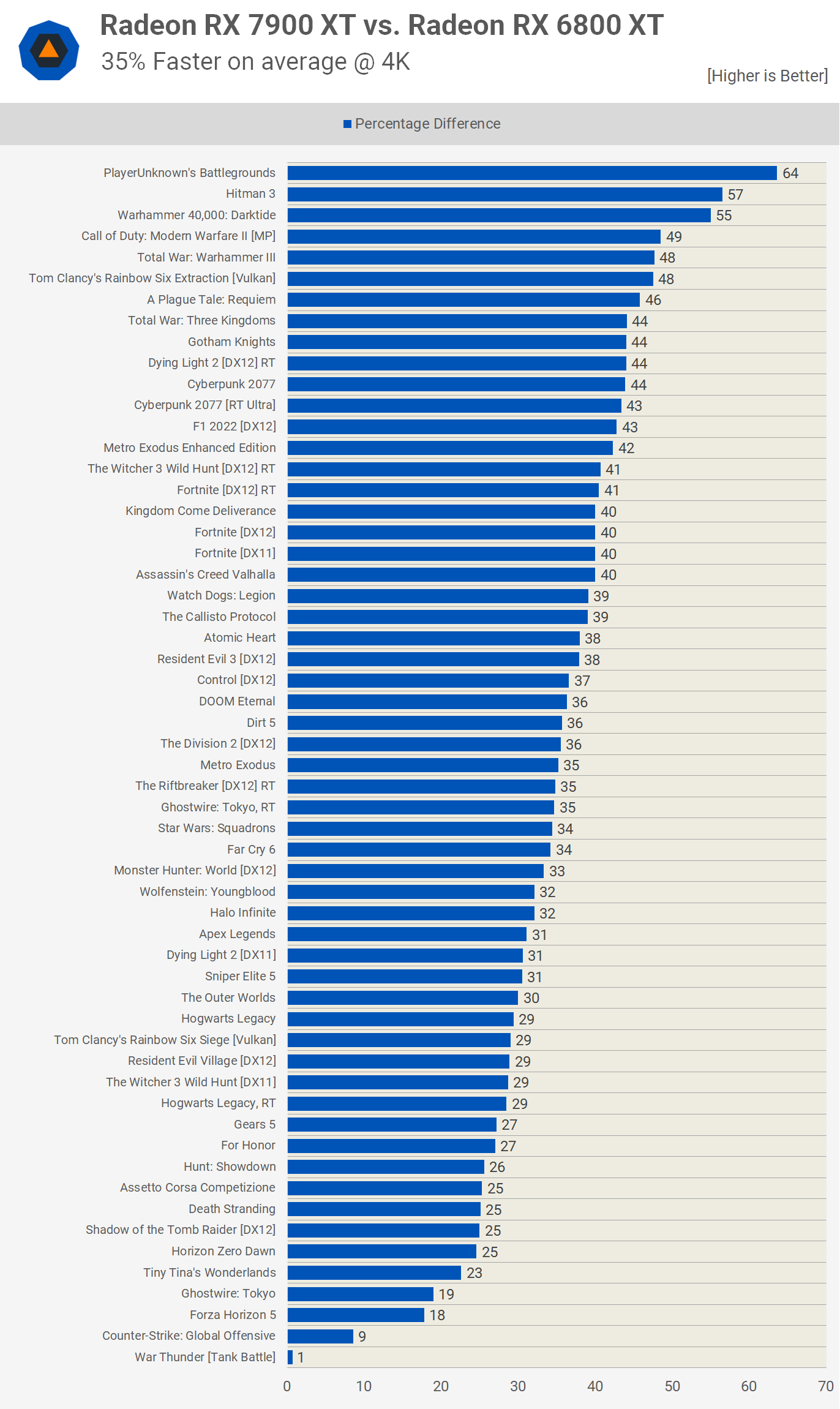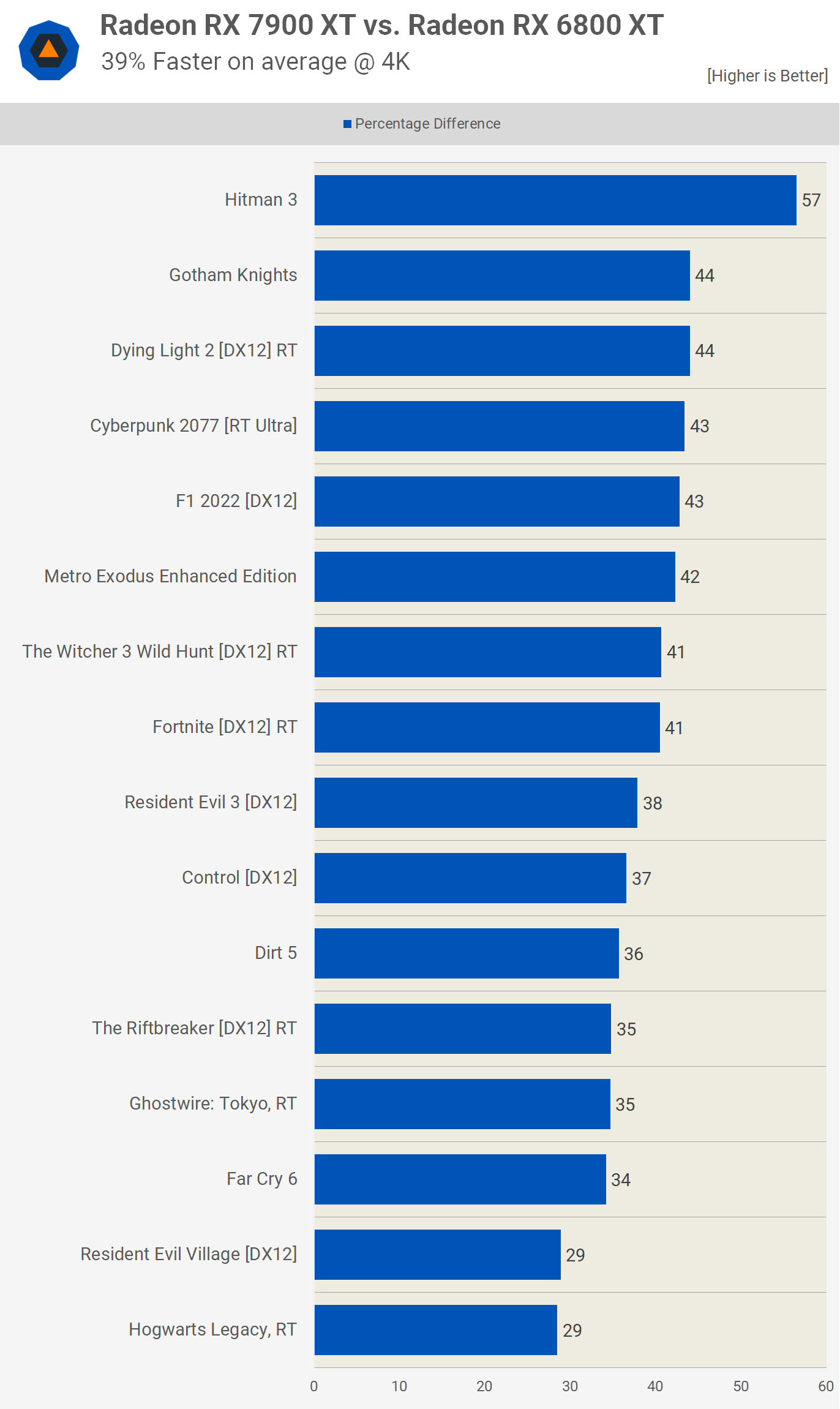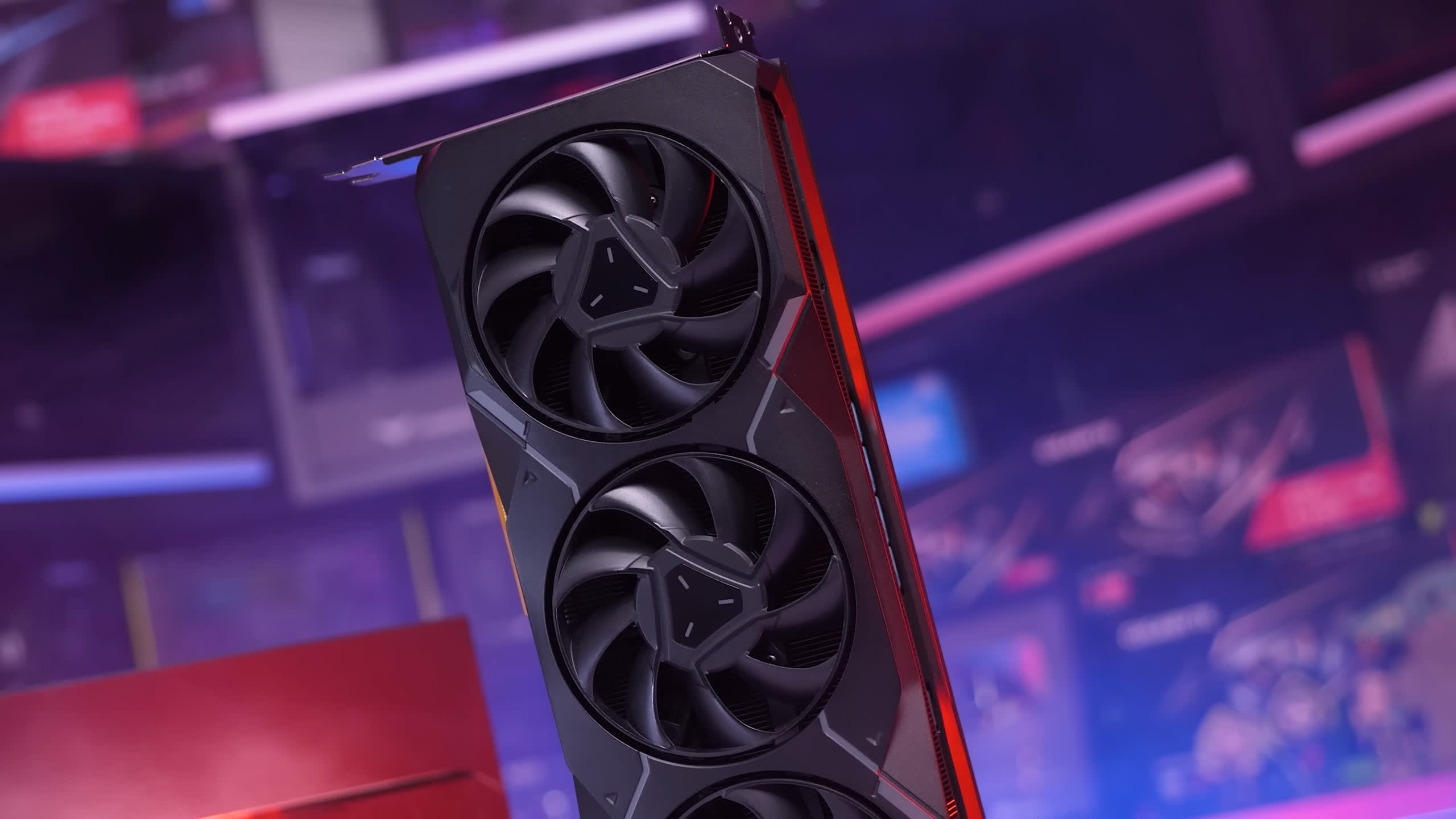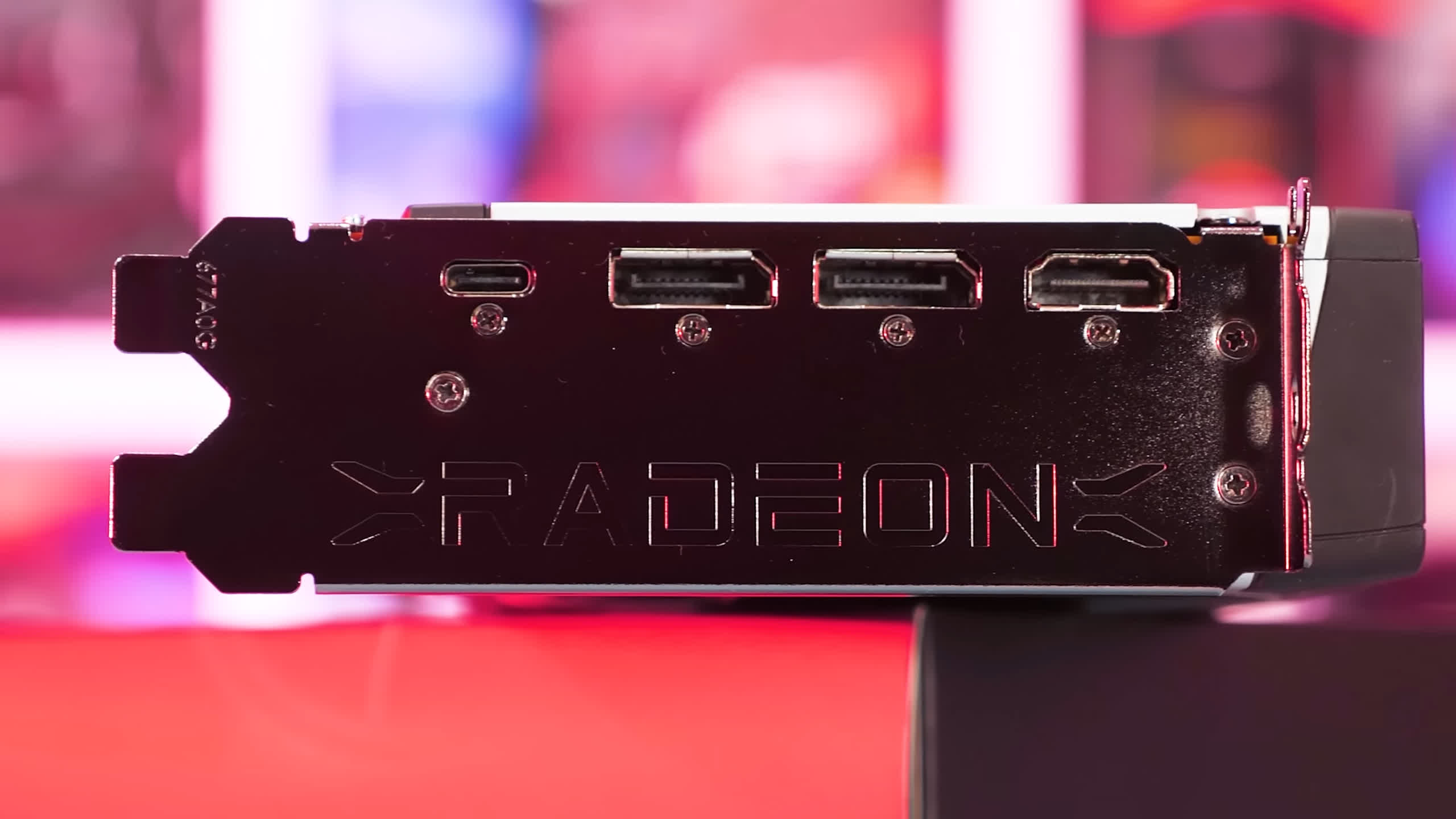Today we're comparing AMD's best value high-end GPU from the previous generation, the Radeon RX 6800 XT, to the new Radeon RX 7900 XT, which with a recently discounted price of $800 is kind of decent value for gamers shopping in the premium segment.
We want to see how these two GPUs compare in a massive sample of games, but you might be wondering, why the 6800 XT and not the 6900 XT or 6950 XT? The reason is that the Radeon 6800 XT was the sensible choice among Radeon GPUs, much like how the RTX 3080 10GB was the last sensible GeForce GPU, at least based on the MSRP.
Typically you could expect to pay ~50% more for the Radeon 6900 XT for a mere 10% boost over the 6800 XT. These days, the 6900 XT is all sold out, leaving the 6800 XT at around $570, while the Radeon 6950 XT can be had for $680, making it ~20% more expensive for roughly ~20% more performance.
We could have used either the Radeon 6800 XT or 6950 XT for this comparison, but ultimately decided on the 6800 XT as it was the more sensible product at the MSRP. It was also available for a longer period of time, and was generally much more affordable, so we believe considerably more Radeon 6800 XT's were sold to gamers.
With that out of the way, let's talk about the match up. The AMD Radeon 6800 XT was released back in November 2020 for $650, but due to the crypto boom, getting any graphics card near that MSRP was mission impossible at the time.
Meanwhile, the Radeon 7900 XT would be 38% more expensive at its suggested $900 retail pricing at launch. However, it didn't take long for AMD to admit this was too high and dropped that to $800 which is more acceptable. At that price, the newer Radeon is 23% more expensive than the 6800 XT's MSRP, while current retail pricing sees the new 7900 XT costing 40% more.
Based on user poll data from three years ago, we know most PC gamers want to see at least a 50% performance uplift before you'll consider upgrading your GPU, and presumably this should be at around the same price point that you originally purchased at.
So if you had bought the 6800 XT at the MSRP, that means the 7900 XT is already just over 20% more expensive, and thus ideally it'd need to be at least 60% faster, if not 70-80% faster for 6800 XT owners to pull the trigger on the upgrade. That's a problem for AMD as we're about to discover.
For powering our test system we used is the Ryzen 9 7950X3D but with the second CCD disabled. We do this to ensure maximum performance in all games, essentially testing with upcoming 7800X3D. This CPU has been tested on the Gigabyte X670E Aorus Master using 32GB of DDR5-6000 CL30 memory.
As usual we'll go over the data for around a dozen titles before jumping into the big breakdown graphs. The resolutions of interest are 1440p and 4K.
Benchmarks
First we'll take a look at Cyberpunk 2077 using the high quality preset with upscaling disabled. The Radeon 7900 XT is 33% faster than the 6800 XT at 1440p and 44% faster at 4K, so in this example RDNA 3 is scaling much better than RDNA 2 as the resolution increases. 4K performance was a weakness of AMD's previous architecture, so it's good to see this has been addressed with RDNA 3.
AMD also improved ray tracing performance with RDNA 3, though we're not seeing any evidence of that with this game.
Enabling RT effects with the aid of FSR upscaling, the Radeon 7900 XT was 36% faster at 1440p and and 43% faster at 4K. That's basically the same margins we observed without RT.
Dying Light 2 using the high quality preset enables DX11 and provides us with what should be a fairly typical result. The Radeon 7900 XT is 32% faster at 1440p and 31% faster at 4K.
Not a huge win for the newer Radeon GPU, but again this is typically what we'd expect to see, especially with ray tracing disabled.
Speaking of which, enabling the high quality ray tracing preset which requires DX12, we see that the 7900 XT is now 46% faster at 1440p and 44% faster at 4K, so the RDNA 3 architecture is scaling better here, but performance overall isn't amazing with just 67 fps at 1440p - though that's certainly more enjoyable than 46 fps. In that sense, the Radeon 7900 XT is more usable for those hoping to enable RT effects.
Surprisingly, the Radeon 7900 XT is much faster in Call of Duty Modern Warfare II, pumping out an impressive 174 fps at 1440p to make it almost 50% faster than the 6800 XT.
The margin remains the same at 4K, where the 1% lows of the 7900 XT matched the average frame rate of the 6800 XT. A big win here for the newer Radeon GPU.
The Radeon 7900 XT also offers big performance gains in A Plague Tale: Requiem with 46% greater frame rates at 1440p and 4K. This is a strong showing for the new RDNA 3 GPU and would be enough to entice most into upgrading, assuming the price was similar, which it isn't.
Warhammer III also sees big performance gains for the 7900 XT, delivering 45% more frames at 1440p and 47% more at 4K. The 4K uplift will be especially noticeable as were going from 44 fps to a much smoother 65 fps in that example.
The Callisto Protocol enables FSR by default with the ultra quality preset, so we've not altered that configuration. Under these conditions the Radeon 7900 XT is 41% faster at 1440p and 39% faster at 4K, a solid performance uplift ignoring the cost increase.
Atomic Heart is another game that sees nearly a 40% increase at both tested resolutions. The Radeon 6800 XT is more than capable at 1440p with 74 fps on average and with some tweaks to the visuals you could get that up around 100 fps.
The real difference can be seen for those of you targeting 4K, where the 6800 XT fell below 60 fps, so again some tuning of the setting could get you to 60 fps without much of a visual downgrade, but you'd also get closer to 90 fps with the 7900 XT.
Moving over to Fortnite the Radeon 7900 XT is just 29% faster than the 6800 XT at 1440p, which is a reasonable performance uplift. Again, it's at 4K where you will really notice the difference between these two GPUs.
Switching to DirectX 12 degrades the performance of both GPUs in Fortnite and now the Radeon 6800 XT is good for just 60 fps at 1440p, making the 7900 XT 34% faster, while it was once again 40% faster at 4K.
With hardware ray tracing enabled along with upscaling we don't see a huge change to the margins, at 1440p the 7900 XT was 33% faster and then 41% faster at 4K, so very similar to what was seen without RT enabled.
Next up we have Hogwarts Legacy, where the Radeon 7900 XT is 34% faster at 1440p using the ultra quality preset and 29% faster at 4K. Fairly mild gains compared to what we've seen so far.
Enabling ray tracing in the same game blows out the 1440p margin to 48% at 1440p, though oddly we're still only seeing a 29% margin at 4K. Performance for both GPUs is roughly halved when compared to what was seen at 1440p.
Moving on to Halo Infinite we're looking at a 24% margin at 1440p. Certainly one of the smallest margins seen so far, and then 32% at 4K, though both did deliver highly playable performance, but you could argue that the Radeon 7900 XT enabled a better high refresh rate experience.
Forza Horizon 5 is one title where RDNA 3 performs the worst relative to RDNA 2. At 1440p the Radeon 7900 XT was just 8% faster than the 6800 XT and then 18% faster at 4K. Scaling at 4K is better on the newer GPU, but performance overall is weak in this title.
Death Stranding is another weak title for RDNA 3. Here the Radeon 7900 XT is just 5% faster than the 6800 XT at 1440p, which you could claim looks like CPU limited data.
The 4K results certainly back that claim as the Radeon 7900 XT is 25% faster, which a big improvement over 5% but well below what we've typically found.
In War Thunder we're entirely CPU limited using the highest in-game quality settings. There's not much to glean from these results, other than to say that for those of you primarily playing less visually demanding titles such as War Thunder, upgrading from a 6800 XT is going to be a waste of time (and money).
Counter-Strike Global Offensive results are similar to those from War Thunder as the game is mostly CPU limited, especially at 1440p. At 4K the Radeon 7900 XT was slightly faster, though we're talking about a minor 9% improvement.
Performance Summary
After looking at 14 of the 50 games we tested, some with ray tracing effects enabled, it's time to see how these two GPUs compare across the entire lineup of games.
Starting with the 1440p data, on average the Radeon 7900 XT is 32% faster than the 6800 XT, which is a mild performance increase, especially given that at MSRP the 7900 XT costs 23% more or 40% based on current retail pricing.
We did see performance gains as high as 59%, with over 40% gains in 16 of the games tested. That said there were 19 titles where performance ranged from 20-30%, leading to a 32% margin overall.
Jumping up to 4K didn't change the overall result. The Radeon 7900 XT is 35% faster on average, though we did see numerous games where the extra 20-40% resulted in much smoother performance at 4K.
Those of you hoping to game at 4K, the Radeon 7900 XT is a more impressive upgrade over the 6800 XT than the 35% result would have you believe. But sadly, given the difference in price, that doesn't change that in terms of value the Radeon 7900 XT is somewhat underwhelming, even at $800.
Out of interest, we removed any game test that had ray tracing enabled and recalculated the averages. This reduced the Radeon 7900 XT's lead over the 6800 XT at 1440p to 30%, a minor 2% difference compared to the data seen previously combining all the results.
It's a similar story at 4K, we're looking at a 2% change down from 35% faster for the 7900 XT to 33% faster.
How about just looking at ray tracing-enabled titles? Well, at 1440p the 7900 XT was on average 39% faster across the 16 titles tested. That's up 7% when compared to the combined results. Not a massive change, but it's clear that for the most part RDNA 3 handles ray tracing a bit better than RDNA 2.
We're looking at the same 39% improvement on average at 4K for the Radeon 7900 XT over the 6800 XT.
What We Learned
If you're shopping around for a new Radeon GPU or looking to upgrade, you now know that across a wide range of games the Radeon 7900 XT is about 30% faster than the 6800 XT (without ray tracing enabled), and closer to 40% faster with ray tracing enabled.
Those are decent gains, though the performance uplift isn't necessarily the concern here, Rather it's the price creep. As we've noted in this article, today you're faced with having to spend 40% more on the Radeon 7900 XT over the 6800 XT.
If the Radeon 6800 XT was still selling at the $650 MSRP, then the Radeon 7900 XT would be a bit more exciting at $800, as you'd be paying a little over 20% more for what typically amounts to a little over 30% more performance.
But as it stands right now, the 6800 XT and 7900 XT could be members of the same product family. Surely, the 7900 XT is more power efficient, but with both GPUs consuming a similar level of power, gamers are hardly going to care.
We'd certainly pay the premium for the Radeon 7900 XT over the 6800 XT if we were interested in ray tracing, but then if that were the case you're generally much better off with a GeForce GPU, like the RTX 4070 Ti, for example.
In our opinion, it's not a situation where you'd be tossing up between these two products. if you've got $800 to spend on a GPU and you want the best performance possible, the Radeon 7900 XT becomes the obvious choice. But if your budget is $600 and you're not willing to stretch it any further, then you buy what you can afford and right now nothing beats the Radeon 6800 XT at $570.
The current GeForce alternative would be the 8GB RTX 3070 Ti, which can be had for $600, but the 6800 XT is on average ~20% faster and with twice the VRAM, it appears to be the better buy.
As for upgrading, that's not on the cards either. If there was an RDNA 3 product that offered 30-40% better performance than the 6800 XT at the same price, then based on polling data that would only be enough of an uplift to entice around 30% of you to upgrade, so hopefully AMD and Nvidia's next generation of GPUs will offer a lot more.
But actually, we went back and polled gamers again, asking the exact same question in 2023 and now 50% of you would only upgrade for a 60% or larger performance uplift. This kind of makes sense as graphics cards are now more expensive than before, so if you're going to spend more you're going to want more. Not great news for AMD and Nvidia though... the Radeon 7900 XT is roughly twice as fast as the Radeon 5700 XT, but it also costs twice as much, and we call that poor progress over a 4-year period.
